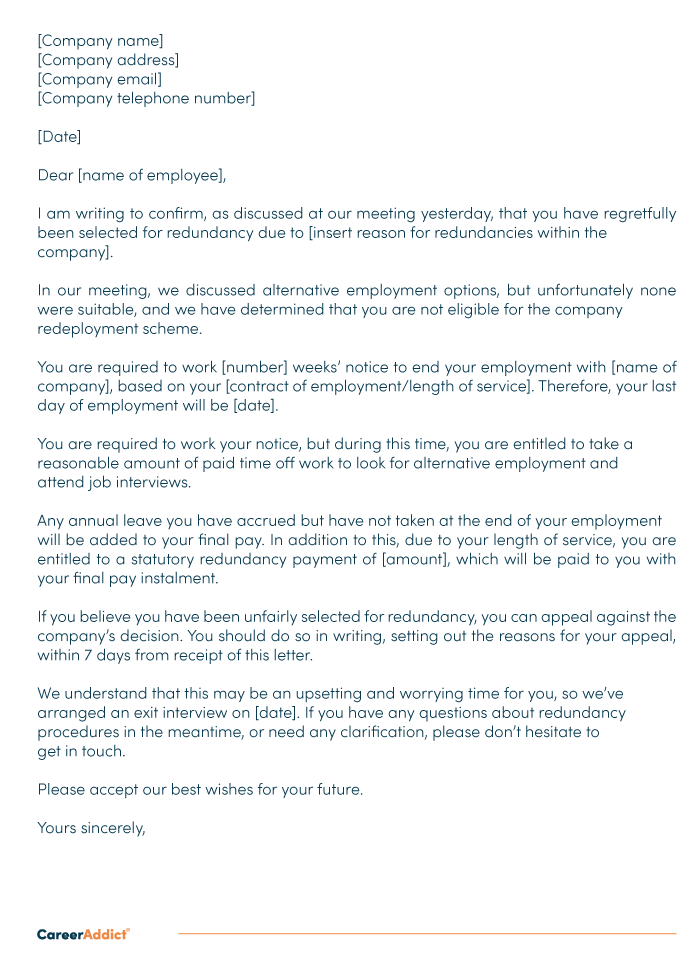Who Pays Redundancy Money? An In-depth Guide for Companies and Employees
Who Pays Redundancy Money? An In-depth Guide for Companies and Employees
Blog Article
Checking Out the Interaction In Between Firm Redundancy and Business Versatility for Future Development
In the dynamic landscape of today's service world, the intricate connection between company redundancy and organizational flexibility becomes a crucial factor for sustained growth and success. Companies often deal with the obstacle of striking a delicate equilibrium between preserving a level of redundancy to minimize dangers and cultivating adaptability to respond promptly to the ever-evolving market demands. This fragile interaction holds the key to not only enduring in stormy times yet additionally growing despite unpredictability. As we explore the multifaceted measurements of this interplay, interesting insights right into exactly how companies navigate these complexities to pave the method for future development wait for.
Importance of Business Redundancy
Business redundancy is a critical aspect that enhances business durability and minimizes operational dangers. By incorporating redundancy procedures within the organizational structure, companies can better withstand unforeseen disturbances and changes in business environment. Redundancy works as a calculated buffer, allowing business to adjust and respond effectively to unforeseen obstacles without endangering necessary procedures.
One secret aspect of the significance of firm redundancy is its function in ensuring continuity throughout times of situation. When confronted with sudden changes or emergency situations, repetitive systems, sources, or employees can step in to keep crucial features and prevent widespread disruptions. This connection not only safeguards the business's track record and client count on yet also lessens economic losses and functional downtime.

Strategies for Business Adaptability

Another essential method is purchasing technology and infrastructure that can sustain versatility and scalability. Implementing digital tools, automation, and information analytics can streamline operations, improve efficiency, and supply useful understandings for educated decision-making. Additionally, producing adaptable organizational frameworks that permit quick changes to market dynamics and customer needs is vital for staying affordable in a rapidly evolving environment. By proactively recognizing potential disturbances and chances, companies can proactively flourish and adjust in an ever-changing service landscape.
Balancing Redundancy and Flexibility
Attaining a harmonious balance in between operational redundancy and business adaptability is critical in navigating the complexities of a dynamic company environment. Striking the best equilibrium between redundancy and adaptability is a delicate procedure that calls for a deep understanding of the company's objectives, market dynamics, and risk resistance.
To achieve this equilibrium, business need to perform normal assessments of their operations to determine areas where redundancy is essential for danger mitigation and where flexibility can drive advancement and growth. Implementing versatile structures, fostering a society of continuous understanding and renovation, and encouraging open communication across all levels of the company are vital methods to integrate redundancy and flexibility effectively. By aligning these two important aspects, companies can place themselves for sustainable growth and success in an ever-changing company landscape.
Instance Research Studies on Adaptation Success
In analyzing instances of successful business adaptation, it comes to Bonuses be evident that the interaction between functional redundancy and versatility is a defining factor in shaping durable services. A DVD rental service, Netflix demonstrated amazing versatility by transitioning right into a streaming platform when digitalization disrupted the industry. These case studies underscore the value of operational redundancy paired with business flexibility in fostering lasting development and competitiveness.
Building Durability for Future Development
Structure durability for future development needs a strategic placement of functional processes with market characteristics and arising fads. Firms need to adjust to altering atmospheres by promoting a culture of adaptability, technology, and continual enhancement. Resilience includes not only getting better from troubles yet also proactively planning for future obstacles. One key facet of structure strength is buying robust risk monitoring approaches to alleviate potential interruptions. This includes scenario planning, diversifying supply chains, and developing contingency prepare for various backups (who pays redundancy money).
Additionally, promoting strong relationships with stakeholders, such as consumers, staff members, providers, and the neighborhood, is vital for weathering uncertainties and keeping trust and assistance during stormy times. Reliable interaction and openness play a crucial role in building durability, as they aid align expectations and help with cooperation in browsing uncertainties.
Additionally, organizations require to prioritize discovering and growth campaigns to upskill staff members and furnish them with the necessary devices to adjust to altering circumstances. By buying their workforce, firms can improve their versatility blog and agility, inevitably reinforcing their durability for lasting future growth.
Conclusion

In the dynamic landscape of today's service globe, the complex relationship between company redundancy and business versatility emerges as an important factor for sustained development and success. Companies frequently face the obstacle of striking a delicate equilibrium between maintaining a degree of redundancy to minimize risks and promoting adaptability to respond promptly to the ever-evolving market demands.To accomplish this balance, business require to carry out normal evaluations of their operations to recognize areas where redundancy is necessary for my blog danger mitigation and where flexibility can drive advancement and growth.In conclusion, the interplay between business redundancy and business flexibility is essential for future development. Building durability through a mix of redundancy and versatility will certainly ensure that firms are prepared for the obstacles of the future.
Report this page